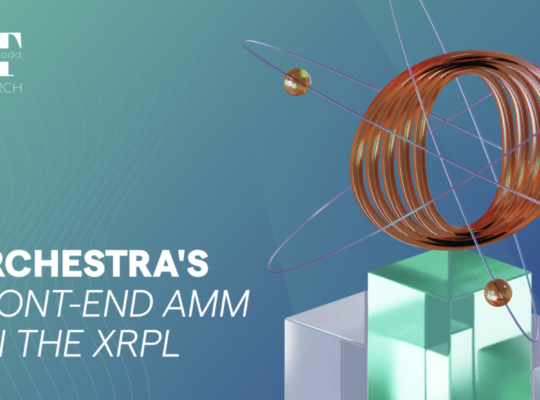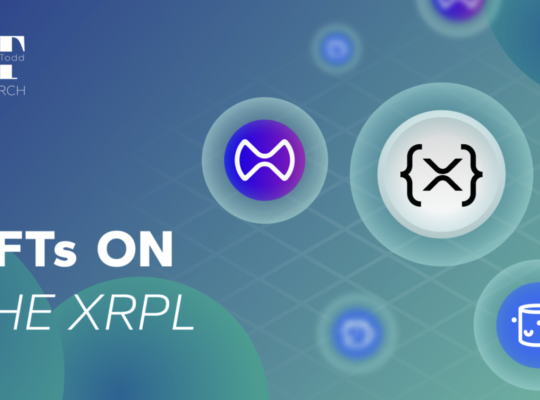The XRP Ledger (XRPL) has many different applications, such as DeFi, NFTs, decentralized identity (DiD), and more. However, the XRPL’s most substantial competitive edge lies in its carefully designed architecture that makes it well-suited for a broad spectrum of institutional use cases.
In particular, there exist 6 architectural advantages over competing networks that I’ll cover below:
- High-Speed, Low-Cost: Many EVM networks remain congested and frequently cost upwards of $0.50 per transaction. An XRPL transaction costs only fractions of a cent.
- Programmability: Potential for complex programmability at the protocol layer, rather than the smart contract layer.
- Aggregated Liquidity: Liquidity is aggregated at the protocol layer, rather than fragmented across AMMs, with much deeper liquidity for institutional-level trading.
- Superior Pricing: The combination of both an AMM-style DEX and orderbook-style DEX, in combination with the pathfinding algorithm, means that the best prices are always executed in a manner not possible with others.
- Built-In Compliance: Authorized Trustlines ensure compliant assets and users.
- Interoperable Liquidity: The XLS-38d bridge connects the XRPL to other networks, with more supported soon.
High-Speed, Low-Cost
Ethereum’s scalability issues have resulted in high gas fees that price out many users and hinder global adoption. Even Ethereum’s primary scaling solutions known as Layer 2 protocols (e.g. Polygon, Arbitrum, Optimism) remain congested and suffer from moderate gas fees. Despite the upcoming proto-danksharding (EIP-4844) update reducing fees, full danksharding is still years away and may not be sufficient enough to globally scale the EVM ecosystem.
Meanwhile, the XRPL can already settle transactions within 3-5 seconds and only charges a fraction of a cent. This makes it ideally suited for retail users in developing nations and institutional use cases such as high-frequency trading and payments. As blockchain begins to impact every industry, having a highly scalable, fast, and low-cost network is a necessity.
It’s worth noting that other networks such as Solana are comparably inexpensive, with great communities as well. I expect they’ll also grow, but they may be focused on specific areas. For example, Solana may ultimately have a stronger DeFi ecosystem than the XRPL, while XRPL’s unique features (explained below) and institutional partnerships position it ahead elsewhere.
Core Programmability
Most blockchains have smart contracts built on top of the protocol layer, which makes it easy for developers to launch new projects and innovate. However, it also introduces the risk of smart contract bugs, rugpulls, and more.
The XRPL is unique in the sense that it has advanced capabilities built into the protocol layer itself. A benefit of this is that any updates or changes go through a significant review process by Validators, limiting risk to the XRPL as a whole.
There are also two downsides to this:
- Launch time: new use cases take longer to implement due to the extensive review process.
- Innovation: as new implementations require careful scrutiny, developers cannot simply implement any possible functionality or feature that they see fit.
This could arguably make it more challenging for the XRPL to keep up with other completely permissionless blockchains where a custom smart contract can be quickly launched. The flip side is that any XRPL updates are likely to be very high-quality, and highly secure which again suits institutional use cases.
Aggregated Liquidity
Blockchains have distinct decentralized exchanges (DEXs) that each have their respective liquidity pools, in turn fragmenting network liquidity. For example, there are now over 1,000 DEXs according to DeFiLlama.
The XRPL network has protocol-wide liquidity, meaning that there’s only a single liquidity pool for each asset pool. This makes it easy for developers to build DEX interfaces without being required to bootstrap liquidity, creates much deeper liquidity, and results in significantly reduced slippage for users.
I covered this in my original XRPL AMM Twitter thread.
Superior Pricing
There are two distinct DEX architectures:
- AMMs: reliant upon liquidity pools and always able to execute trades. They also provide better pricing when there is low-to-moderate liquidity.
- Order books: Common to TradFi and therefore intuitive to use, with better pricing in a highly liquid market.
The XRPL combines both architectures to ensure the best possible trading price is executed.
This complements both the pathfinding and autobridging algorithms, which the XRPL’s Payment Engine uses to always find the best trading path possible. Pathfinding finds the best trading path between two separate assets using an intermediary current to facilitate the trade (e.g. USD → BTC → YEN) while autobridging uses XRP as the intermediary asset.
This hybrid DEX architecture, on top of both pathfinding and autobridging, provides the best pricing possible and again complements institutional adoption.
I covered pathfinding and autobridging in this Twitter thread here.
Built-In Compliance
Authorized Trustlines on the XRPL represent a bidirectional relationship that connects an account with a token issuer. For example, it could connect an XRPL user holding USDC with the on-chain asset issuer of that token, like BitStamp.
Trustlines allow token issuers to maintain on-chain whitelists of user accounts that are eligible to hold their token, based on various criteria such as KYC, accreditation, background checks, etc.
Other security features such as the Clawback also tick legal checkboxes for interested institutions and will be important for bringing real-world assets (RWAs) on-chain. Overall, trust lines and security features make it significantly easier for institutions to compliantly move on-chain, which is particularly important for bringing RWAs onto the blockchain.
I covered the Clawback in-depth in this Twitter post.
Interoperable Liquidity
Most EVM blockchains are now interconnected to one another, as well as to at least a handful of non-EVM networks.
The XRPL recently announced the XLS-38d bridge which will connect the XRPL to various sidechains. For example, the EVM Sidechain will enable EVM code to be deployed within the XRPL ecosystem, expanding potential use cases.
While this isn’t a differentiator from other networks, it expands the range of assets available to the XRPL. This further strengthens the XRPL’s ability to execute payments and other financial services at the best rates possible, perfectly suited for institutions.
I covered the EVM Sidechain and XLS-38d bridge in this Twitter thread here.
Concluding thoughts
Different blockchains will be best for different use cases. Blockchain will have so many potential applications that it’s not a winner-takes-all market, although power dynamics will apply and there will be specific winners for certain categories.
Cross-border payments, high-frequency trading, the tokenization of real-world assets, remittances, and countless more use-cases are possible through the XRPL’s unique design and extensive institutional partnerships.
Fortunately, it’s a network with lots of potential for those keen on building and making a difference.
Interested in learning more about the XRPL or getting started?

If so, book a call with me and let’s chat!




